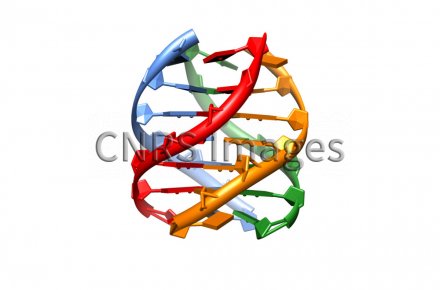Production year
2010

© David MONCHAUD/ICMUB/CNRS Images
20160101_0006
Example of the structure of a tetramolecular quadruplex (Protein Data Bank ID: 139D). This quadruplex DNA is comprised of four strands, 7 nucleotides long. Its structure was obtained by NMR (nuclear magnetic resonance spectroscopy). The sequence here mimics the Tetrahymena telomeric sequence (a ciliate protozoan). Quadruplexes are non-usual DNA structures that offer an additional level of gene regulation. In contrast to the permanent double helix structure of DNA, the very dynamic structures of quadruplexes comprise four strands rotating around each other. G4s may form in no less than 716,000 locations in our genome. They may be involved in a number of biological processes that are indispensable to the correct operation of the cell, such as chromosome stability or DNA replication. This might explain their role in the development of several rare neurodegenerative or infectious diseases.
The use of media visible on the CNRS Images Platform can be granted on request. Any reproduction or representation is forbidden without prior authorization from CNRS Images (except for resources under Creative Commons license).
No modification of an image may be made without the prior consent of CNRS Images.
No use of an image for advertising purposes or distribution to a third party may be made without the prior agreement of CNRS Images.
For more information, please consult our general conditions
2010
Our work is guided by the way scientists question the world around them and we translate their research into images to help people to understand the world better and to awaken their curiosity and wonderment.